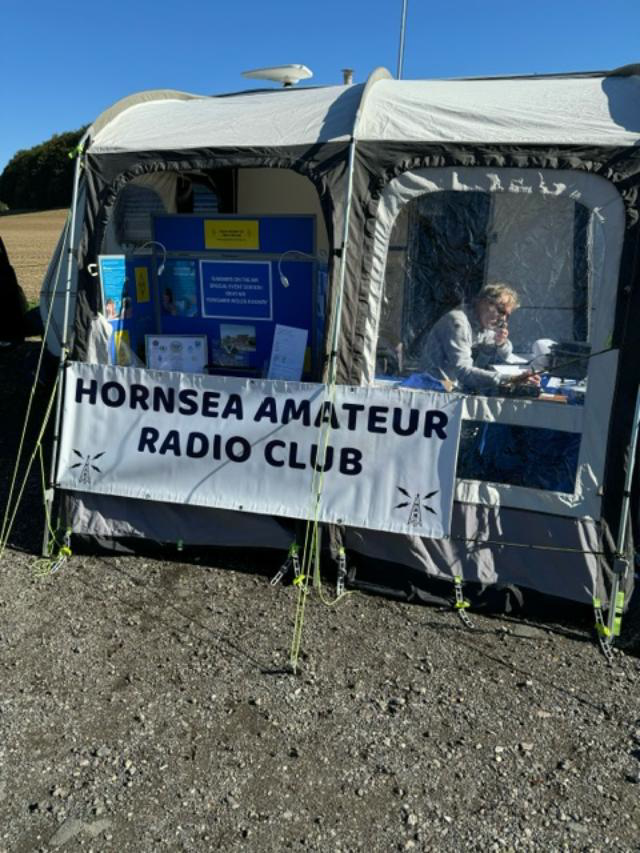
Download

On the weekend of 28/29 September, Hornsea Amateur Radio Club (HARC) were invited to put on a special event radio station at Fimber Halt to celebrate the anniversary of the first steam powered passenger railway which took place on 27th September 1825 - the first passenger train ran on a line in the North East of England from Darlington to Stockton.

The radio station was allocated the callsign GB4YWR by OfCom and was operated by Mike G4SMB and Jim 2E0TMM from the Hornsea club with a visit from the club Chairman, Graham M1ASR.
The weather was kind, Saturday was bright and sunny, Sunday a tad overcast.
Visitors to the Yorkshire Wolds Railway came along to have a look and listen to the radio station after their visit to view the displays and history of the Fimber Halt railway and a train ride on Eddie, a diesel-hydraulic 5576 0-4-0 shunter built in 1979.
A total of 51 contacts were made on the radio with 17 heritage railways contacted. Other railway enthusiasts called in from around the UK and Europe including Holland and Belgium.
All in all, a splendid weekend with excellent hospitality from the volunteer staff of Yorkshire Wolds Railway. HARC will be back next year to celebrate the 200th anniversary of steam railways.
Mike G4SMB/GB4YWR
HARC Hon Sec
Phoito shows Mike G4SMB operating
According to researchers, the C and X-shaped formations are evidence that we still have much to learn about the ionosphere and its impact on communication and navigation signals passing through it.
Similar shapes have been observed before, but this time, they were noticed in places where scientists did not expect them and appeared at surprising moments. The NASA Observations of the Limb and Disk (GOLD) mission aided in the more detailed observation of the C and X-shaped formations. Its main goal is to measure density and temperature in our planet's thermosphere and ionosphere.
Mysterious shapes in the ionosphere
NASA reminds us that the ionosphere, which stretches from 50 to 600 kilometres above our heads, becomes electrically charged during the day when sunlight hits the Earth. Its energy knocks electrons out of atoms and molecules. This creates a mixture of charged particles, called plasma, which allows radio signals to be transmitted over long distances. The mentioned plasma is also influenced by the Earth's magnetic field, creating the shapes above.
"Near Earth’s magnetic equator, charged particles are funnelled upward and outward along magnetic field lines, creating two dense bands of particles north and south of the equator that scientists call crests. As night falls and the Sun’s energy fades, low-density pockets in the plasma, called bubbles, can form in the ionosphere. Because of their varying density, the crests and bubbles can interfere with radio and GPS signals," NASA explains in a press release.
solar storms and significant volcanic eruptions but also during so-called "quiet time." This suggests that local factors play a more significant role in these processes. Additionally, computer models indicate that lower atmosphere conditions are likely causing downward plasma movement.
"Earlier reports of merging were only during geomagnetically disturbed conditions - it is an unexpected feature during geomagnetic quiet conditions," said Fazlul Laskar, an ionospheric physicist from the University of Colorado.
Scientists were also surprised by the appearance of plasma, shaped like the letter C and its inverse. These formations, likely created by winds on Earth, appeared close to each other at a distance of about 630 kilometres. Observing such shapes is rare they have been noticed only twice. Consequently, scientists on the GOLD mission plan further studies to understand exactly what causes their formation. "Within that close proximity, these two opposite-shaped plasma bubbles had never been thought of, never been imaged," noted Deepak Karan, an ionospheric physicist from the University of Colorado.
The plasma in the ionosphere is crucial for long-distance radio wave transmission, and the latest discoveries help better understand how radio and GPS systems work. This is especially true since disturbances in the ionosphere, such as those observed, can affect communication and navigation infrastructure.
Could a coronal mass ejection wipe out all electronics? Neil deGrasse Tyson and comedian Matt Kirshen learn about
The Carrington Event, eclipses, and how the Parker Solar Probe doesn’t melt with heliophysicist Lika Guhathakurt.